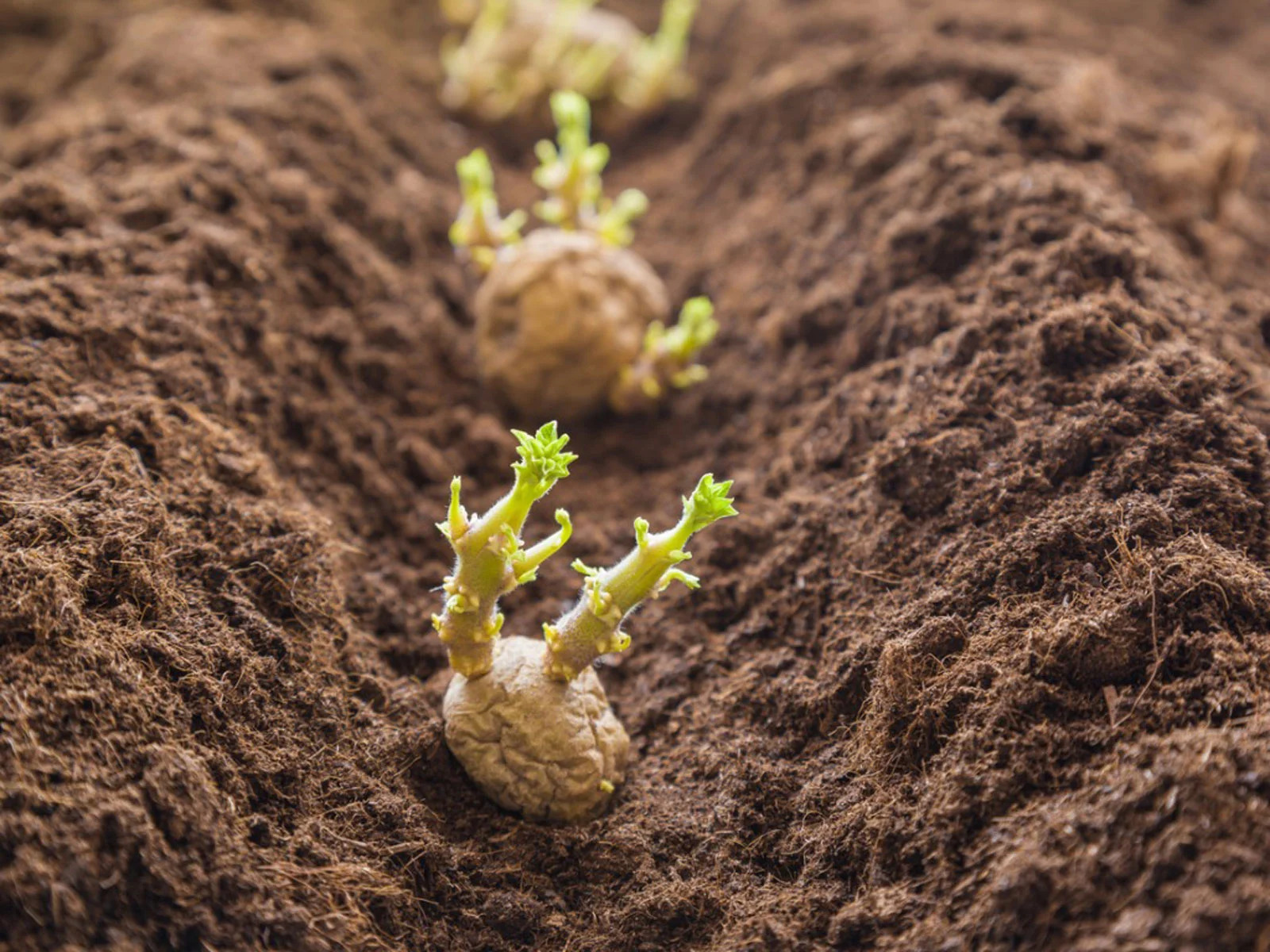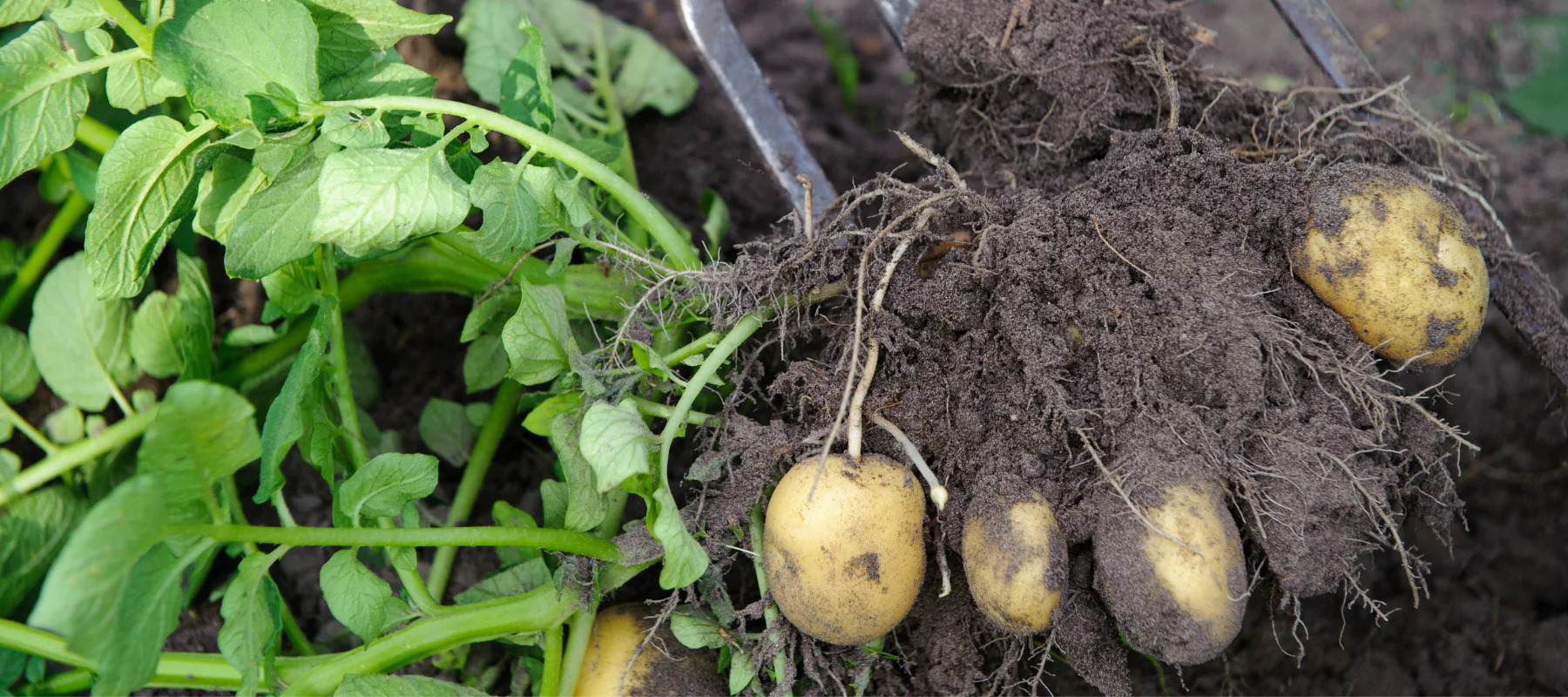How To Grow A Potato Plant
Growing your own potatoes is an exciting and rewarding process that can be done even in a small space. Growing from seed potatoes, rather than planting actual potato seeds is important, as this will give you the best results and chance of success.
There are over 100 varieties available to gardeners which can vary in shape, size and color, these are traditionally sold by local growers or garden stores.
How to Plant Potatoes
When it comes to planting potatoes, the timing is crucial. For cold climates, such as northern Europe and the United States, planting should take place in mid-to late-spring. In warmer climates, planting potatoes should occur either late in the summer or winter months, so they will be able to grow without being exposed to the intense heat of the sun.
To plant your potatoes correctly, begin by cutting seed potato pieces with eyes facing up and place them 6 inches deep into holes or trenches. Make sure to leave 12 inches of space around each piece before adding fertilizer, when doing this use 2 tablespoons of low-nitrogen fertilizer with high phosphorous content for maximum growth and quality.
Finally, cover both seeds and fertilizer with 2 inches of soil then thoroughly water it all in. Taking care when planting your potatoes will help ensure a successful crop and many delicious meals!
Potato Care
The key to getting the most out of your potato crop is proper light management. Potatoes need full sun for at least 6 to 8 hours per day in order to achieve top growth and compensate for their root growth. Areas that receive partial shade can also suffice, but will not support the same yield as those exposed to more direct sunlight.
To further aid potatoes' top growth, many gardeners choose to "hill" soil around growing plants. This practice can keep the tubers safe from any harmful sun rays that may cause them discoloration or greening on the skin.
Hilling your potatoes can give them even better access to light and protection from interference, as well as help create a more cohesive environment where water can be retained more effectively and other vegetation might have an easier time growing and competing for resources with the potatoes.
Soil
Potatoes need neutral to acidic soil in order to thrive and produce optimal harvests. Soils with a pH of 5.0-6.0 are best for growing potatoes, as higher pH levels may lead to the spread of scab, which leaves unsightly spots on the potato tubers.
A looser, well-draining soil is necessary for proper growth and healthy development of potato crops. While richer soils might have additional nutrients that benefit other plants, an excessive amount of organic nutrients can lead to stunted growth in potatoes and reduce yields.
Additionally, heavy clay soils will require preparation before planting potatoes because they do not give the tuber roots adequate room to grow and gather essential nutrition.
To remedy this problem, prepare the soil by adding backhoe material or simply loosen it down to the desired depth with a spade or shovel before planting potatoes. With quality soil conditions like these in place, you’ll be sure your potato crop has everything it needs for successful growth!
Water
Water is an essential part of maintaining a healthy potato crop. Potato plants require at least one inch of water every week in order to thrive and produce high-quality potatoes. For best results, water the plants as frequently as possible, ensuring that the soil is moist but not soggy.
By allowing the soil to dry out between watering cycles, potatoes can be grown with optimal yields by avoiding plant stress or disease caused by over-watering.
To protect against drought during blooming season, mulch deeply around each plant at the beginning of the growing season. Mulching helps keep moisture in by slowing evaporation from the ground, preventing soil temperatures from becoming too hot.
Furthermore, it gives added support and nutrition to the potatoes' roots while controlling weeds and helping retain valuable topsoil. By providing sufficient attention to water retention when caring for potato plants, growers can be assured that they will receive good yield and quality tubers at harvest time.
Temperature and Humidity
Potatoes are a staple of many diets around the world, and are a popular crop for farmers and gardeners. Before planting them, it is important to consider the temperature of the soil - potatoes need 45 degrees Fahrenheit as a minimum for planting, but preferably 50 degrees Fahrenheit.
Too much heat can stop potato plants from growing, which is why it’s best to plant in cooler summer climates or as winter crops in hotter places. It also helps to mulch around the plants with something like straw, as this can keep the soil up to ten degrees cooler than it would be otherwise.
When it comes to humidity, potatoes don't have a preference - so long as the temperature of the soil is right and there’s enough water available without having constantly wet feet, they should grow fine.
If they do happen to be planted during humid summer months then air circulation should be monitored closely, especially at night-time when fungus diseases are more likely. As long as temperatures and moisture levels are monitored correctly though potatoes make an easy addition to any diet!
Fertilizer
Fertilizer is a great way to help ensure that your plants receive the essential nutrients they need to thrive and produce healthy yields. When planting potatoes, using an organic, slow-release fertilizer is important for giving the plants the right amount of nutrition over a long-term period.
If you use too much fertilizer in one go it could overwhelm the plant and damage its growth. Additionally, every couple of weeks you should give your potatoes a feeding with diluted liquid fertilizer or fish emulsion for a boost of nutrients.
Potato Varieties
When it comes to potatoes, there are seemingly endless varieties to choose from. Generally speaking, potatoes can be divided into three categories: Russets and long white potatoes, round white potatoes, and red-skinned potatoes.
Early-season Varieties
The 'Irish Cobbler' potato is a popular variety for those looking for an early-season harvest. This variety has tannish skin and an irregular shape, which makes it well-suited for boiling and mashing dishes. It grows in soil that is well aerated, and growers should be sure to keep the water content even throughout the growing season.
Another great option for an early-season harvest is 'Norland'. It has smooth red skin with white flesh that cooks up quickly. In addition to being ideal for boiling and mashing recipes, 'Norland' potatoes are also great when baked or roasted. For this type of potato, it's important to plant in soil that drains well and can hold enough moisture throughout the growing season.
Finally, there's 'Mountain Rose', another popular choice for an early-season harvest. This variety grows perfect red and rose colored skin with white flesh underneath that is great for steaming as well as baking and roasting recipes. Plant in light, sandy soil that does not flood or become too soggy from heavy rains. With careful maintenance this potato will yield a generous harvest of delicious potatoes ready to use in various recipes!
Mid-season Varieties
Mid-season varieties are an important part of the potato growing process, offering a range of options for farmers and gardeners alike. One popular variety is 'Red Pontiac', known for its red skin and white flesh. It is a good choice for boiling, baking, and frying, with a medium-dry texture that makes it an ideal all-purpose potato.
Another mid-season variety is 'Viking', a very productive red-skin potato that is great in salads or stews. Some gardeners also choose to grow 'Chieftan', which is known to be resistant to potato scab and stores well after being harvested.
All these potatoes provide a unique flavor experience and can become the centerpiece of many classic dishes. With so many different varieties available, there's something sure to please everyone when using mid-season potatoes in recipes.
Late Varieties
Late varieties of potatoes, such as ‘Katahdin’, ‘Kennebec’, and ‘Elba’ are ideal for harvesting in late autumn. These tan skinned potatoes are bred to be resistant to some viruses and late blight while also being able to resist potato scab.
'Katahdin' has a light tan skin with round tubers that store well and 'Kennebec' is another type of late variety that is also tan-skinned with good resistance to various viruses and late blight. The third popular variety is 'Elba', which offers large round tubers and good blight resistance.
Propagating Potatoes
Propagating potatoes is surprisingly simple and can be a fun way to start your own potato garden. As its name suggests, seed potatoes are not actually true seeds – they are full-size potatoes that have been bred specifically for the purpose of producing more potatoes.
When these potatoes are planted into soil, they start to sprout shoots from the potato eyes, which can happen naturally when you leave them stored in your kitchen cabinet for too long. You can either plant a whole seed potato or cut it into pieces, each piece should have at least one eye in order to grow correctly.
It’s important to let the cut pieces form calluses by exposing them overnight - this helps to prevent rot which could occur if the soil is too cool or wet. Growing a crop of delicious potatoes has never been easier!
Harvesting
Harvesting new potatoes is a fun and rewarding process. If you have planted your potatoes around 50 days ago, the plant should be close to one foot tall, if not already there. This is when you can begin harvesting some of the small immature potatoes without fully affecting the plant.
To do this, simply feel around near the base of the plants to get an idea of where the potatoes are located and then gently pull them out. It’s important however to note that it will still take two to four months (roughly 120 days) for the potatoes to reach their full size.
Once those days have passed, you can go ahead and collect your entire crop by checking when the tops of the plants start dying off - this signals that they are ripe for harvesting!
Common Pests And Plant Diseases
Potatoes are a popular vegetable crop, but unfortunately they are prone to many common pests and plant diseases. Adults of beetles and aphids can defoliate the plants, leaving them weakened and susceptible to damage. To keep these pests under control it is important to monitor early in the season before they become a major problem.










